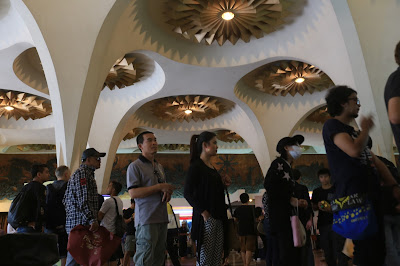Starting in the late 19th century and going forward, Chinese migration to Thailand was encouraged by successive reigns of Thailand's ruling Chakri Dynasty. In their push to modernize the country, the Chakri King's invested heavily in canals and, later, trains, opening up new lands to resource extraction, crop extension and the various industries which they spawned. Chinese immigrants often settled along the canal fronts and train lines, jockeying for position to best capitalize off the new modes of transport.
The general pattern would be for a first generation immigrant-entrepreneur to set the stage for future capital accumulation. From there, the second generation would take the helm. In Bang Saphan Noi, young Prayat Phatanaphanich did just that. From tailor, to cloth merchant, to clothier, who bought some land, planted a coconut palm plantation and made a fist full of baht. Profits from one enterprise were reinvested in others, diversifying revenue streams, often resulting in little local empires.
By the early 1980's, the Phatanaphanich's were an established business family in the town. Bang Saphan Noi was also still largely electricity free, as were many parts of rural Thailand at the time. Only the well heeled could afford the luxury. As such, demand for leisure activity after work was done was high. What better thing to do with all that excess cash than bring cinema to your neighbors?
In 1981, Prayat Phatanaphanich and a few other investors built The Bang Saphan Noi Theater. It was erected on land adjacent to his plantation, turning over another adjacent plot for the construction of a Chinese temple and housing for his numerous relatives and employees, some of whom worked in the theater.
Modern vernacular architecture with stars on the cornice. So be the Bang Saphan Noi Theater
Two types of temples. One for ancestor worship, the other for the gods of cinema.
Architecturally, The Bang Saphan Noi Theater is a simple structure, highlighted by the use of ornamental metal stars bolted to the cornice around the sign board. Realistically, there wouldn't have been any need to distinguish the theater any further with a flashy design. Despite that, it's still a fairly imposing structure, tucked away behind the town's main drag. And in this post-stand-alone movie theater era, it would serve as a jaw dropping surprise to anybody who unwittingly chanced upon it. Nobody in their right mind equates small town Thailand with massive movie theaters anymore (except maybe the two or three of you who read this blog regularly).
Open-air lobby of the Bang Saphan Noi Theater
Ticket window iron work.
Mr. Surin Jinthanaphan standing in the gutted auditorium, where he worked as GM for the duration of the theater's working days.
I was fortunate to come across Mr. Surin Jinthanaphan at his house just next to the dormant movie theater. After a casual chat about his hulking concrete neighbor, Surin revealed that he is a member of Phatanaphanich family and worked as the general manager from start to finish.
Picking his brain for a half hour or so shed more light on the local nature of the movie theater business in rural Thailand from not so long ago.
Most theaters in Thailand at the time still relied on the services of professional voice actors do live dubbing for foreign language films. At smaller theaters, a pre-recorded tape of the dubbing session was often supplied rather than pay the high cost of booking the dubber for a live show. Not so for the Bang Saphan Noi Theater, which, despite being a small market, had an in-house dubber by the name of Nahyo, who also resided in the town.
The 600 seat theater was indeed the central meeting place for just about the entire town until the mid-1990's, when Bang Saphan Noi got wired for full scale electricity. Immediately after that attendance fell, as townsfolk increasingly opted to stay glued to the TV at home rather than venture out to the theater. The theater closed shortly afterwards and has been vacant ever since.
But in its short operating life, the Bang Saphan Noi Theater was a harbinger of bigger things for a town well below the radar. It's probably safe to say that Bang Saphan Noi's most lively era was during the brief span when it had its very own movie theater.



















